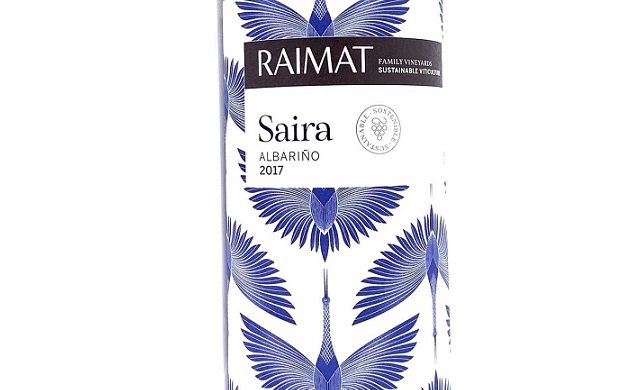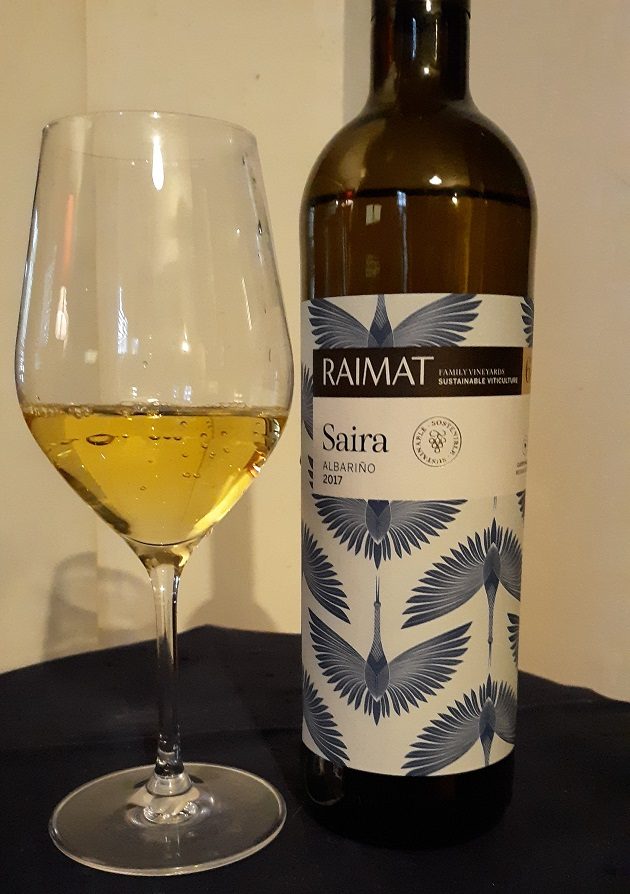
If it hasn’t begun already, the grape harvest should be getting underway in Spain this month. As the growing season wanes and summer gives way to autumn, winemakers in Spain – and across the Northern Hemisphere – will be watchful for that perfect moment when the fruit is at its absolute peak – a sign that the hectic work to collect a year’s worth of product in just a few days can finally begin.
If they can spare a glance upward, the busy grape-pickers might also be treated to another portent of the changing seasons in the Iberian skies overhead: the sight of flocks of White Storks (Ciconia ciconia) heading south from their summer breeding grounds in Europe to Africa, where they spend the winter on the warm savannas. Our wine of the week – the 2017 Raimat Saira Albariño – features these graceful, long-necked birds on its label, where the storks take shape in a flying formation of lovely geometric abstractions reminiscent of the work of Charley Harper. Raimat notes with pride that the sight of these storks and their nests is a common one in the Catalan wine country northwest of Barcelona where the winery is found, a circumstance it attributes in part to the sustainable land practices of the company. In fact, Raimat can also be credited for the return of people to this part of Spain; until Manuel Raventós founded his 7,900-acre winery here in 1914, the Catalan countryside northwest of the ancient city of Lleida had been an uninhabited – and unirrigated – backwater for nearly three-hundred years following an 17th-century uprising – though the ruins of a medieval Arab castle on the winery property attest to the older human history here. Raimat is now part of the Costers del Segre Denominación de Origen and is owned by the Raventós Cordoníu Group, one of the oldest wine companies in the world (dating from 1551) and the oldest producer of cava, the traditional Spanish sparkling wine.
![]()
If the storks have been making the great journey back and forth between Spain and Africa long before people even began making wine, the feature grape of this single-varietal wine – the green-skinned Albariño – is a more recent arrival to Catalonia. In fact, Raimat was the very first Spanish winery to produce an Albariño wine outside of the traditional homeland of this cultivar. Though it’s one of the best-known native grapes of Spain, the origins of Albariño lie instead in the westernmost part of that country, far from the irrigated fields of Catalonia, where the weather and even the language can be quite different.
Albarino cultivation is traditionally associated with the region of Galicia in the northwestern corner of Spain, where the rocky and rugged landscape juts into the Atlantic along a coastline considered the edge of the known world in Roman times. Here by the sea, the grape found a natural home in the remote, windswept terrain, and wines made from the Albariño – most notably those made in the Rías Baixas Denominación de Origen – are said to acquire a pleasing salinity from the Atlantic salt air that blows over the inland vineyards, making the wines of this region a natural partner for the mostly marine provender found on Galician menus. The grape is also grown just over the border in the northern Portuguese regions of Monção and Melgaço, where it’s known as Alvarinho and especially valued in the production of vinho verde, (“green wine”) a light, sparkling, slightly tart Portuguese specialty.
Now that it’s grown at Raimat in the high Catalonian plateau west of the Balearic coast, Albariño faces a quite different set of conditions. The hot and dry summers of the prevailing Mediterranean climate contrast sharply with the milder, wetter growing seasons of the Atlantic coast, yielding a Catalan Albariño with a softer, but perhaps less characterful expression than their Galician forebears.
While they may not be in quite the same league as the greatest Rías Baixas Albariño, Catalan wines produced with this grape still make an impressive wine that partners well with light, summery fare. The 2017 Raimat Saira Albariño boasts a bright, botanical but slightly yeasty bouquet redolent of white flowers, peach, orange blossom, and gooseberry. Melon and vanilla stand out on the palate, while the moderate acidity and minerality of this wine combine for a fresh, pleasing finish.

Good birding and happy drinking!
Raimat Saira Albariño (2017)
![]()
![]()
![]()
![]()
![]()
Three out of five feathers (Good).
Birds and Booze News:
Night Lizard Brewery in Santa Barbara, California is making news with its commitment to environmental activism, as related in this article in the Antioch University Odyssey. The brewery names each of its beers after endangered species of California’s Central Coast, including the California Gnatcatcher (Polioptila californica) and Scripp’s Murrelet (Synthliboramphus scrippsi).
The California Condor (Gymnogyps californianus) now has another beer raising funds for its conservation with the release of a second Zoo Brew at the Santa Barbara Zoo, a Mexican amber lager.
Cape Charles Brewing Company of Cape Charles, Virginia is hosting Birds, Brews, & BBQ on 14 September, with a portion of the proceeds going to Birding Eastern Shore.











Leave a Comment